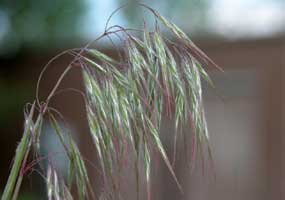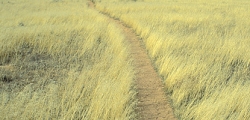
Photo Courtesy NPS, Photographer:
Tom Heutte, USDA Forest Service,
Bugwood.org
 A grassland inundated by cheatgrass
A grassland inundated by cheatgrass
Photo Courtesy NPS
Neal Herbert, Photographer
Hi, this is Mark Larese-Casanova from the Utah Master Naturalist Program at Utah State University Extension.
It’s difficult to visit a landscape in the West without encountering cheatgrass. While cheatgrass’ small stature might make it hard to notice, it’s impossible to forget its sharp, spiny seeds. One hike through a cheatgrass meadow can render a good pair of socks unsalvageable.Encountering Cheatgrass
Although cheatgrass, a nonnative grass scientifically known as Bromus tectorum, is an annual grass- germinating, growing, producing seeds, and dying each year- it is particularly effective at colonizing disturbed areas because it grows and produces seeds much earlier in the spring than many perennial native grasses. Cheatgrass monopolizes water and nutrients by germinating and establishing itself during the previous fall and winter, when many native plants have become dormant. Over time, cheatgrass has become the dominant ground cover in many of Utah’s sagebrush ecosystems.
The dense, dry, fine stalks of cheatgrass, which sets seeds and dries out by June, are particularly flammable fuel for wildfires. Fire roars through the carpet-like cover of cheatgrass, and wildfires are now at least twice as frequent as they were in the 1800’s. This has caused a loss of sagebrush habitat that is particularly important to a wide diversity of wildlife. More frequent fires create an even greater challenge for rare species such as the black-footed ferret and desert tortoise to survive. Native grasses are slower to recover from fire, and cheatgrass is particularly effective at recolonizing burned areas. Utah State University researchers Dr. Peter Adler and Aldo Compagnoni have found that reduced snowpack and warmer temperatures promote the growth of cheatgrass, which could potentially increase its distribution and fire risk into previously colder areas of Utah.
Researchers and managers are continually working to find ways to control cheatgrass in Utah. Effective control usually involves a combination of mechanical pulling or tilling, grazing, burning, spraying with a chemical herbicide, and replanting with native grasses. USU researchers Dr Eugene Schupp and his former graduate student Jan Summerhays found that applying a pre-emergent herbicide to prevent the germination of cheatgrass seeds, as well as temporarily limiting Nitrogen in the soil, gave native grasses and perennials a better chance of establishing. When faced with such a large management problem in Utah and throughout the West, we can use all of the helpful tools we can get.
For Wild About Utah, I’m Mark Larese-Casanova.
Credits:
Images: Courtesy NPS, Neal Herbert Photographers
and NPS, USDA Forest Service, Bugwood.org, Tom Heutte Photographer
Text: Mark Larese-Casanova, Utah Master Naturalist Program at Utah State University Extension.
Additional Reading:
Beck, George. Cheatgrass and Wildfire. Fact Sheet No. 6.310. Colorado State University Extension. https://www.ext.colostate.edu/pubs/natres/06310.html
Cheatgrass. Range Plants of Utah. https://extension.usu.edu/range/Grasses/cheatgrass.htm
Fairchild, John. Cheatgrass: threatening homes, stealing rangelands. Utah Division of Wildlife Resources. https://wildlife.utah.gov/watersheds/links/cheatgrass.php
Opsahl, Kevin. USU study: Climate shift could trigger cheatgrass. Herald Journal . October 21, 2012. https://news.hjnews.com/allaccess/article_f1436aee-1a3c-11e2-935a-0019bb2963f4.html
Forero, Leslie, Plants Surviving Cheatgrass Invasion May Improve Restoration Chances, Study Shows, UPR Utah Public Radio, Feb 26, 2018 https://www.upr.org/post/plants-surviving-cheatgrass-invasion-may-improve-restoration-chances-study-shows
Larese-Casanova, Mark, Cheatgrass, Wild About Utah, October 25, 2012 https://wildaboututah.org/cheatgrass/

Cheatgrass is NOT — I repeat NOT — the problem. I have owned land and a home in southernUtah since the 1980’s and have been plagued by ryegrass. This is in the lawn seed / mixed seed we all buy to seed our lawns. Imagine this — calling cheatgrass a problem is like calling a “daddy-long-legs” spider a problem and ignoring the black widow. Ryegrass is like a porcupine on a strong stem. I would love it if my in city lot had cheatgrass on it — but it doesn’t — it has ryegrass on it. in fact ryegrass would be no problem if it were mowed continuously (every week) My dog won’t even go into the lot where the ryegrass is. For us in the water starved desert; ryegrass is so drought tolerant that once it gets a hold and starts to spread out of the city and into agricultural / cattle lands we’ll all be wishing cheatgrass would take over. I’m not sure where cheatgrass started – whether it was imported as seed or is native – but ryegrass is imported as we all go out and buy it for our lawns. I think we need to ban ryegrass in Utah, at least in the dry areas, and Utah is about 1/2 dry area — or desert, if you prefer.
here is a picture labeled “foxtail” – what is in my field – the extension office said it is ryegrass: http://www.meanseeds.com/gallery/foxtail/
there are pictures of “cheatgrass” and other invasive grasses at the same web-site:
http://www.meanseeds.com/resources/the-bad-grass-list/
Hi JD,
I completely agree that foxtial/ryegrass is a huge
problem. It’s hard to get rid of, and can be dangerous to pets. It is
one of several grasses, including bulbous bluegrass and cheatgrass, that
are invasive and difficult to manage. None of them are more important
than the other, but rather all create challenging management issues that
need to be addressed. I’ve been told that, eventually, bulbous bluegrass will be an even bigger problem than cheatgrass.
Good Luck.